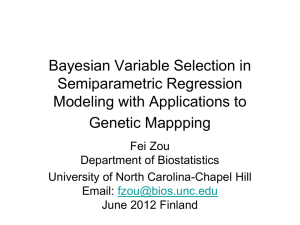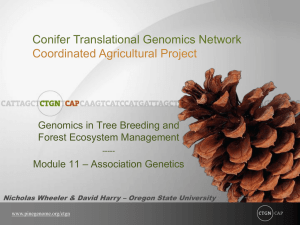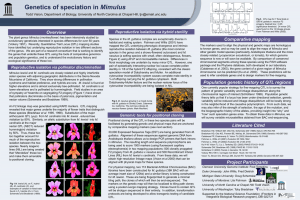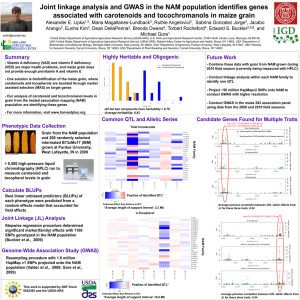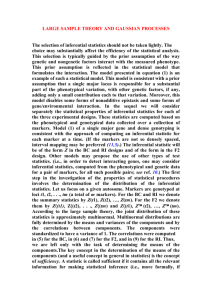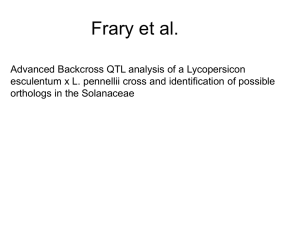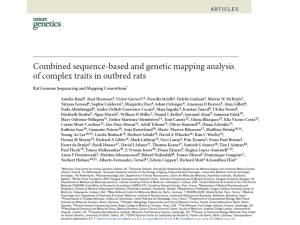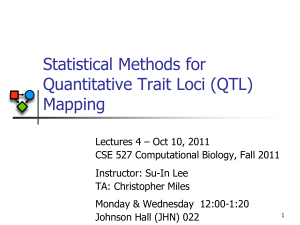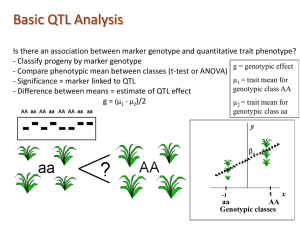122_2009_1021_MOESM1_ESM - Springer Static Content Server
advertisement
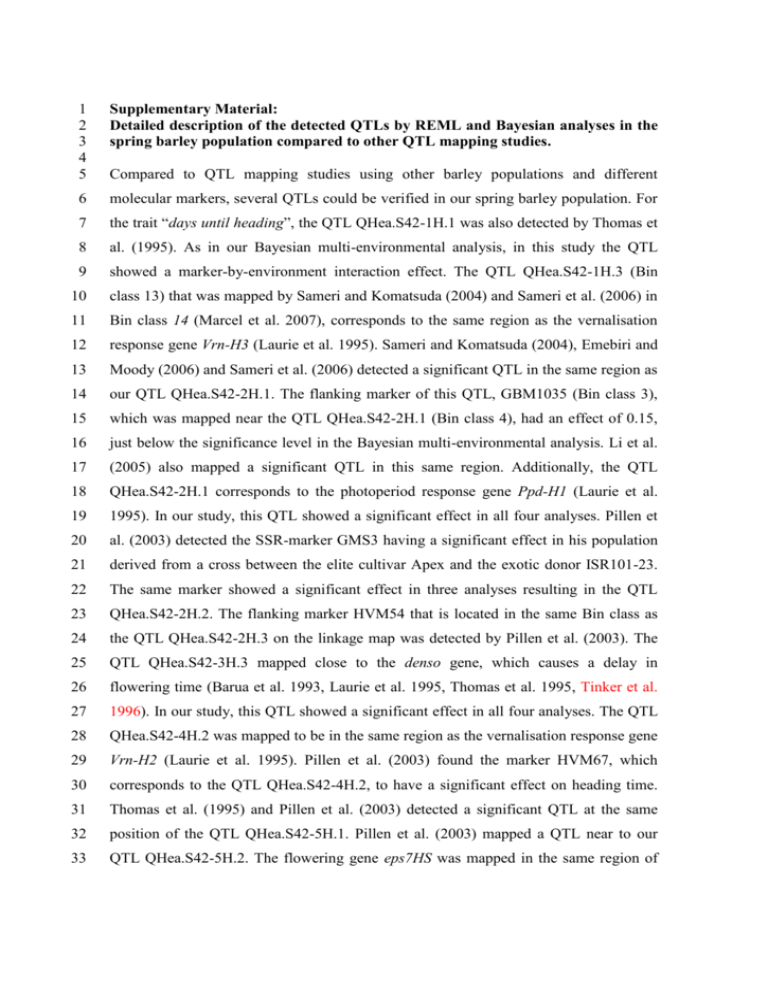
1 2 3 4 5 Supplementary Material: Detailed description of the detected QTLs by REML and Bayesian analyses in the spring barley population compared to other QTL mapping studies. 6 molecular markers, several QTLs could be verified in our spring barley population. For 7 the trait “days until heading”, the QTL QHea.S42-1H.1 was also detected by Thomas et 8 al. (1995). As in our Bayesian multi-environmental analysis, in this study the QTL 9 showed a marker-by-environment interaction effect. The QTL QHea.S42-1H.3 (Bin 10 class 13) that was mapped by Sameri and Komatsuda (2004) and Sameri et al. (2006) in 11 Bin class 14 (Marcel et al. 2007), corresponds to the same region as the vernalisation 12 response gene Vrn-H3 (Laurie et al. 1995). Sameri and Komatsuda (2004), Emebiri and 13 Moody (2006) and Sameri et al. (2006) detected a significant QTL in the same region as 14 our QTL QHea.S42-2H.1. The flanking marker of this QTL, GBM1035 (Bin class 3), 15 which was mapped near the QTL QHea.S42-2H.1 (Bin class 4), had an effect of 0.15, 16 just below the significance level in the Bayesian multi-environmental analysis. Li et al. 17 (2005) also mapped a significant QTL in this same region. Additionally, the QTL 18 QHea.S42-2H.1 corresponds to the photoperiod response gene Ppd-H1 (Laurie et al. 19 1995). In our study, this QTL showed a significant effect in all four analyses. Pillen et 20 al. (2003) detected the SSR-marker GMS3 having a significant effect in his population 21 derived from a cross between the elite cultivar Apex and the exotic donor ISR101-23. 22 The same marker showed a significant effect in three analyses resulting in the QTL 23 QHea.S42-2H.2. The flanking marker HVM54 that is located in the same Bin class as 24 the QTL QHea.S42-2H.3 on the linkage map was detected by Pillen et al. (2003). The 25 QTL QHea.S42-3H.3 mapped close to the denso gene, which causes a delay in 26 flowering time (Barua et al. 1993, Laurie et al. 1995, Thomas et al. 1995, Tinker et al. 27 1996). In our study, this QTL showed a significant effect in all four analyses. The QTL 28 QHea.S42-4H.2 was mapped to be in the same region as the vernalisation response gene 29 Vrn-H2 (Laurie et al. 1995). Pillen et al. (2003) found the marker HVM67, which 30 corresponds to the QTL QHea.S42-4H.2, to have a significant effect on heading time. 31 Thomas et al. (1995) and Pillen et al. (2003) detected a significant QTL at the same 32 position of the QTL QHea.S42-5H.1. Pillen et al. (2003) mapped a QTL near to our 33 QTL QHea.S42-5H.2. The flowering gene eps7HS was mapped in the same region of Compared to QTL mapping studies using other barley populations and different 1 the QTL QHea.S42-7H.1 (Emebiri and Moody 2006) and coincides with a QTL 2 detected by Pillen et al. (2003). 3 4 For the trait “plant height”, the QTL QHei.S42-2H.1 was mapped to the same region as 5 the candidate gene Ppd-H1 (Laurie et al. 1994), which has a strong pleiotropic effect on 6 plant height. The QTL Qhei.S42-2H.2 was also detected by Kraakman et al. (2006) and 7 is located in the same region as the dwarfing gene sdw3 (Gottwald et al. 2004). The 8 QTL QHei.S42-3H.1 was mapped by Sameri et al. (2006) and the QTL QHei.S42-3H.2 9 (Bin class 10) was found by Yin et al. (1999) in Bin class 11 (following the consensus 10 map of Marcel et al. 2007). The QTL QHei.S42-3H.3 was detected in the same region 11 as the dwarfing gene denso (Thomas et al. 1995, Bezant et al. 1996). This candidate 12 gene reduces plant height, while in our study this QTL has an increasing effect on plant 13 height. It can be assumed that with the QTL QHei.S42-3H.3 another allele of the denso 14 candidate gene was detected. 15 16 For the trait “thousand grain weight”, the QTL QTgw.S42-2H.1 (Bin class 8) was also 17 detected by Pillen et al. (2003), who found the same marker to be significant, and by 18 Sameri and Komatsuda (2007) (Bin class 10, Marcel et al. 2007). The QTL QTgw.S42- 19 2H.2 (Bin classes 9-10) was mapped by Li et al. (2005) in the same chromosomal 20 region. However, the marker used by Li et al. (2005) is located in the Bin class 15 21 (Marcel et al. 2007). Considering the QTL QTgw.S42-7H.1, the SSR-marker Bmag120 22 was found to be significant in Pillen et al. (2003). 23 24 Several QTLs of the trait “grain yield” were detected by other studies. The QTL 25 QYld.S42-1H.1 (Bin class 6) was mapped by Li et al. (2005) in Bin class 8 (Marcel et 26 al. 2007), the QTL QYld.S42-1H.2 by Thomas et al. (1995) and Tinker et al. (1996), 27 and the QTL QYld.S42-2H.1 by Yin et al. (1999). A QTL in the same region as the 28 QTL QYld.S42-3H.1 was mapped by Thomas et al. (1995), Pillen et al. (2003) and 29 Kraakman et al. (2004). There, the QTLs of Pillen et al. (2003) and Kraakman et al. 30 (2004) corresponded to the same Bin class as our QTL QYld.S42-3H.1. The QTL 31 QYld.S42-3H.2 coincided with the QTL detected by Yin et al. (1999). Thomas et al. 32 (1995), Tinker et al. (1996) and Li et al. (2005) could map a QTL corresponding to the 1 QTL QYld.S42-3H.3 that is located in the same region as the candidate gene denso. The 2 QTL QYld.S42-5H.1 was detected by Pillen et al. (2003) and the QTL QYld.S42-5H.2 3 by Kraakman et al. (2004). This last QTL, however, is supposed to be located in Bin 10 4 in our study, while Kraakman et al. (2004) found this QTL in Bin classes 12-13. Further 5 comparisons are necessary to verify whether the QTLs are identical. Pillen et al. (2003) 6 detected the SSR-marker Bmag120, which is near to the QTL QYld.S42-7H.1, to be 7 significant. 8 9 10 11 12 13 14 15 16 17 18 19 20 21 22 23 24 25 26 27 28 29 30 31 32 33 34 35 36 37 38 39 40 41 42 43 References Barua UM, Chalmers KJ, Hackett CA, Thomas WTB, Powell W, Waugh R (1993) Identification of RAPD markers linked to a Rhynchosporium secalis resistance locus in barley using near-isogenic lines and bulked segregant analysis. Heredity 71:177–184 Bezant J, Laurie D, Pratchett N, Chojecki J, Kearsey M (1996) Marker regression mapping of QTL controlling flowering time and plant height in a spring barley (Hordeum vulgare L.) cross. Heredity 77:64–73 Emebiri LC, Moody DB (2006) Heritable basis for some genotype-environment stability statistics: Inferences from QTL analysis of heading date in two-rowed barley. Field Crops Research 96:243–251 Gottwald S, Börner A, Stein N, Sasaki T, Graner A (2004) The gibberellic-acid insensitive dwarfing gene sdw3 of barley is located on chromosome 2HS in a region that shows high colinearity with rice chromosome 7L. Mol Gen Genomics 271:426–436 Kraakman ATW, Niks RE, van den Berg PMMM, Stam P, van Eeuwijk FA (2004) Linkage disequilibrium mapping of yield and yield stability in modern spring barley cultivars. Genetics 168:435–446 Kraakman ATW, Martínez F, Mussiraliev B, van Eeuwijk FA, Niks RE (2006) Linkage disequilibrium mapping of morphological, resistance, and other agronomically relevant traits in modern spring barley cultivars. Mol Breed 17:41–58 Laurie DA, Pratchett N, Bezant JH, Snape JW (1994) Genetic analysis of a photoperiodresponse gene on the short arm of chromosome 2 (2H) of Hordeum vulgare (barley). Heredity 72:619–627 Laurie DA, Pratchett N, Bezant JH, Snape JW (1995) RFLP mapping of five major genes and eight quantitative trait loci controlling flowering time in a winter x spring barley (Hordeum vulgare L.) cross. Genome 38:575–585 Li JZ, Huang XQ, Heinrichs F, Ganal MW, Röder MS (2005) Analysis of QTLs for yield, yield components, and malting quality in a BC3-DH population of spring barley. Theor Appl Genet 110:356–363 Marcel TC, Varshney RK, Barbieri M, Jafary H, de Kock MJD, Graner A, Niks RE (2007) A high-density consensus map of barley to compare the distribution of QTLs of partial resistance to Puccinia hordei and of defense gene homologues. Theor Appl Genet 114:487– 500 Pillen K, Zacharias A, Léon J (2003) Advanced backcross QTL analysis in barley (Hordeum vulgare L.). Theor Appl Genet 107:340–352 1 2 3 4 5 6 7 8 9 10 11 12 13 14 15 16 17 18 19 20 21 Sameri M, Komatsuda T (2004) Identification of quantitative trait loci (QTLs) controlling heading time in the population generated from a cross between oriental and occidental barley cultivars (Hordeum vulgare L.). Breeding Science 54:327–332 Sameri M, Takeda K, Komatsuda T (2006) Quantitative trait loci controlling agronomic traits in recombinant inbred lines from a cross of oriental- and occidental-type barley cultivars. Breeding Science 56:243–252 Sameri M, Komatsuda T (2007) Localization of quantitative trait loci for yield components in a cross oriental x occidental barley cultivar (Hordeum vulgare L.). JARQ 41:195–199 Thomas WTB, Powell W, Waugh R, Chalmers KJ, Barua UM, Jack P, Lea V, Forster BP, Swanston JS, Ellis RP, Hanson PR, Lance RCM (1995) Detection of quantitative trait loci for agronomic, yield, grain and disease characters in spring barley (Hordeum vulgare L.). Theor Appl Genet 91:1037–1047 Tinker NA, Mather DE, Rossnagel BG, Kasha KJ, Kleinhofs A, Hayes PM, Falk DE, Ferguson T, Shugar LP, Legge WG, Irvine RB, Choo TM, Briggs KG, Ullrich SE, Franckowiak JD, Blake TK, Graf RJ, Dofing SM, Saghai Maroof MA, Scoles GJ, Hoffmann D, Dahleen LS, Kilian A, Chen F, Biyashev RM, Kudrna DA, Steffenson BJ (1996) Regions of the genome that affect agronomic performance in two-row barley. Crop Sci. 36:1053–1062 Yin X, Stam P, Johan Dourleijn C, Kropff MJ (1999) AFLP mapping of quantitative trait loci for yield-determining physiological characters in spring barley. Theor Appl Genet 99:244– 253
